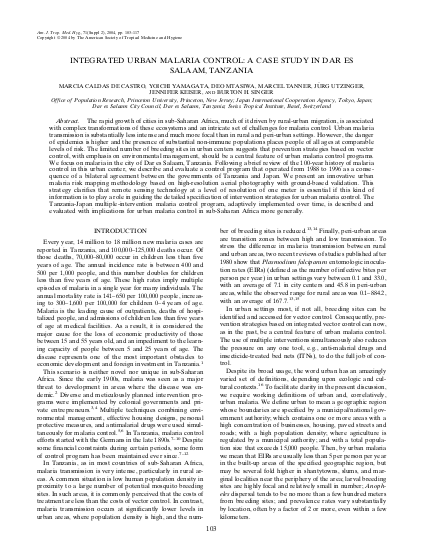
The rapid growth of cities in sub-Saharan Africa, much of it driven by rural-urban migration, is associated with complex transformations of these ecosystems and an intricate set of challenges for malaria control. Urban malaria transmission is substantially less intense and much more focal than in rural and peri-urban settings. However, the danger of epidemics is higher and the presence of substantial non-immune populations places people of all ages at comparable levels of risk. The limited number of breeding sites in urban centers suggests that prevention strategies based on vector control, with emphasis on environmental management, should be a central feature of urban malaria control programs. We focus on malaria in the city of Dar es Salaam, Tanzania. Following a brief review of the 100-year history of malaria control in this urban center, we describe and evaluate a control program that operated from 1988 to 1996 as a consequence of a bilateral agreement between the governments of Tanzania and Japan. We present an innovative urban malaria risk mapping methodology based on high-resolution aerial photography with ground-based validation. This strategy clarifies that remote sensing technology at a level of resolution of one meter is essential if this kind of information is to play a role in guiding the detailed specification of intervention strategies for urban malaria control. The Tanzania-Japan multiple-intervention malaria control program, adaptively implemented over time, is described and evaluated with implications for urban malaria control in sub-Saharan Africa more generally.
Links
Resource collections
- COVID-19 Response Collection
- Evaluating humanitarian action
- Learning from crises
- Monitoring and Evaluation (M&E)
- Monitoring of humanitarian action
- UN Habitat - Urban Response Collection
- Urban Response - Urban Crisis Preparedness and Risk Reduction
- Urban Response Collection - Community Engagement and Social Cohesion
- Urban Response Collection - Economic Recovery
- Urban Response Collection - Environment and Climate Change
- Urban Response Collection - Housing, Land and Property
- Urban Response Collection - Urban Crisis Response, Recovery and Reconstruction
- Urban Response Collection - Urban Resilience
- Use of evaluation evidence